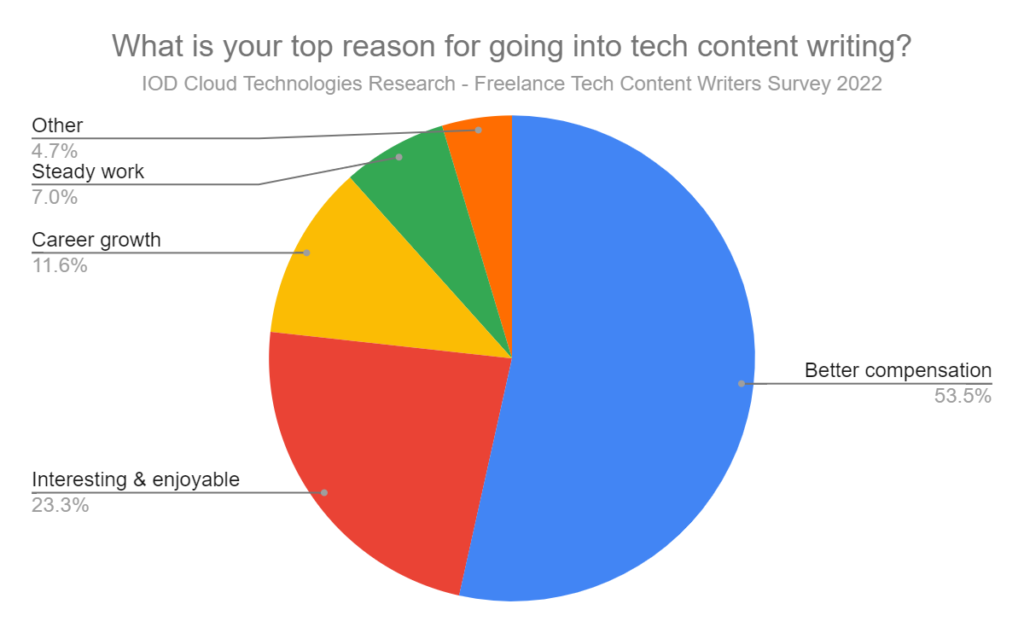If you’re a content marketing writer looking to break into the field of tech marketing writing, the transition can seem daunting. And in fact, many fail.
I remember how overwhelmed I felt when I landed my first tech marketing writing gig. I’d spent over a decade in academia before making the move into tech content, and it was all new territory for me. I was honestly tempted to just throw in the towel but knew that the only way to overcome that and to grow in the field was to invest in the learning process.
With the global IT industry expected to reach $13.8 billion by 2026, tapping into this market can be a smart career move. And it’s no surprise that in our 2022 survey of tech marketing writers, better compensation was cited as the primary reason for going into the field (53%).
But do you have what it takes to become a successful tech marketing writer?
In this blog post, we cover everything you need to know before you take the plunge, how to get started, and the tools you need to succeed.
What Is a Tech Marketing Writer?
A tech marketing writer is not the same as a technical writer. A technical writer creates technical documentation, such as user guides and product manuals. Tech marketing writers, on the other hand, produce both short-form and long-form content (solution briefs, landing pages, blog posts, white papers, ebooks, and more) on technical topics such as cloud, DevOps, cybersecurity, data engineering, or AI/ML—often with product tie-in, whether explicit or alluded.
Tech journalists, bloggers, and influencers all fall under the umbrella of tech marketing writers. These writers may be more specialized, focusing on a single core area, such as fintech; others may write on a wide range of technical subjects.
How Much Tech Knowledge Is Required?
The technical depth of the content will vary depending on the target audience.
For example, a short write-up on the latest app or gadget, a thought-leadership post targeting tech marketers, or content aimed at home users looking for backup software may be less technical, only requiring good research skills to write about.
But a product deep dive geared toward developers and engineers would obviously require more technical knowledge and hands-on expertise, including strong programming skills and practical experience with tech tools and platforms.
While developers and engineers may also create tech marketing collateral, in this blog post, we’ll be focusing on tech marketing writers who are not practitioners in the fields they write about.
Why Become a Tech Marketing Writer?
Creating high-quality content is one of the top challenges marketers face, and even more so for tech marketers.
There’s a real lack of qualified tech marketing writers out there.
At the same time, roughly a third of freelance writers report making less than $20 per hour while 46% struggle to find good clients.
But if you’re able to build up the extremely valuable skill of tech content writing, the gigs will start rolling in. And because it’s such an in-demand skill, you’ll be able to charge more for these projects and be more selective with the clients you choose to work for.
According to IOD’s 2022 tech marketing writers survey, aside from better compensation (as previously noted), writers reported finding the work to be of interest (23%), career growth (12%), and steady work (7%) as the primary reasons for choosing this niche.

Skill Set and Requirements
While many claim to be able to write tech content, and marketing writers often touch upon tech topics, this does not qualify them as tech marketing writers.
But if the foundation is there, it’s certainly a skill you can build up. Nobody is born a tech marketing writer, and as with any skill, there’s a learning process involved.
So what are the basic skills you’ll need to succeed?
Excellent Writing, Research, and Critical Thinking Skills
A good tech marketing writer knows how to find reliable resources and extract valuable information from them in order to convey complex themes in a clear and organized manner:
Strong, independent research skills are key to becoming a successful tech marketing writer. In many cases, the clients will simply provide materials and perhaps a short briefing, but you will be required to do most of the research on your own.
For this reason, researchers and academics from other fields are often able to successfully transition into tech marketing writing. (Though I’ve also seen talented creative writers go on to become esteemed tech marketing writers.)
So how do you go about finding good resources?
- Find credible sources: Start by determining who the main industry players are. For example, if you’re writing about cloud, it’s the Big 3—AWS, Azure, and GCP—who dominate, and their websites and content can serve as a good starting point for your research. Refer to research and consulting firms that address tech topics as well, such as Gartner, IDC, or the Ponemon Institute, for example.
- Check out the competition: Understand who the main competitors are and look at similar content being produced on the topic you’re writing about. It’s also important to know this to avoid external links to competitors (though adding authoritative links can be good for SEO).
- Ensure resources are up to date: The tech scene is constantly evolving, so this is an important point to consider.
- Turn to the company SMEs & marketing professionals: Working with one of the company’s subject matter experts (SME) can be extremely helpful, especially when the content is highly product-oriented. But keep in mind, these busy developers likely won’t be teaching you basic concepts (what cloud is or why DevOps came about, for example) but rather are there to provide you with very specific information about the technical aspects of their product. You’ll also want to request marketing collateral from the marketing team that explains the benefits of their product/service, the pain points it’s addressing, and any unique selling points. So don’t be afraid to ask for the info you need!
In addition to these tips, see the resources section of this article to learn more about specific tech topics.
Once you’ve gathered your information, how do you turn it into an effective piece of content?
- Understand the product/service & competitive landscape: You need to understand how the product or service relates to the topic for product tie-in. Is it a cloud service, for example, geared for Microsoft Azure cloud platform users? Then writing about other cloud services like AWS or GCP may not be relevant. Or perhaps the company has a partnership with AWS, and there should be more focus there.
- Address the target audience: This is key! An article on cybersecurity addressing C-levels may look very different and be much more introductory than an article addressing IT or security team leaders. Each may have very different pain points and varying levels of knowledge on the topic. You don’t want to bore anyone by telling them what they already know or go too technical with a non-technical audience.
- Address the reader’s pain points: Lead into the solution the vendor is offering to address the pain points you outlined. Depending on the client’s preferences, this may constitute an entire section dedicated to explaining the specific product/service, a product comparison, or simply a CTA at the end.
Having strong editorial skills is a bonus too and can make it much easier in cases where you need to rewrite/repurpose existing marketing materials.
Some general editorial/SEO tips include:
- Break down long blocks of text by using more white space and subheadings, bulleted lists, and numbering.
- Avoid filler text and fluff.
Flexibility & Good Communication
Working with clients coming from dynamic, deadline-driven hi-tech environments isn’t always easy. It requires flexibility, patience, and strong interpersonal skills, as I explain below.
Understanding the Tech Landscape
While a tech marketing background isn’t a prerequisite to becoming a successful marketing writer, it’s helpful to understand how things work in the technology industry.
For example, a client may push for an article to be completed ASAP in order to meet their KPIs. You might be scrambling to deliver on time only for the marketing team to end up putting it on the backburner. This may be due to work overload, but it is also important to understand the everchanging tech landscape: As a product/technology evolves, tech companies must adapt. This may mean some projects are put on hold while others become priority.
Perhaps they’ve had to add a new feature to their app in order to keep up with the market. Or, a new security vulnerability may arise requiring changes to their product and/or adjustments to the content to address these concerns. The writer should therefore expect that revisions to the content may be required.
Understanding the Tech Content Review Process
Another factor to be aware of is that the content review process can be slower since producing quality tech content often requires both a technical and marketing review. This is not done by the same person/team.
The marketing team will generally check the messaging as well as things like crosslinks, product mentions, and SEO keywords. Another reviewer (sometimes more than one) will then check for technical accuracy. This is usually done by a senior R&D member that has the required tech expertise.
But there’s often a gap between tech and marketing. It’s important to understand that the dev or engineer’s main focus is to build, test, and deploy (ensuring everything works and it is ready for release) the company’s product/software on time, meaning they may be stressed and overloaded. Often, the technical team doesn’t consider content a high priority either. This can lead to poor collaboration between marketing and R&D teams, and the content may end up “stuck” in tech review.
Streamlining the Work
Establishing a clear and efficient work process in advance that takes all of this into account will make for a much more pleasant work experience. Working with a content production hub or agency like IOD who is able to offer substantial, ongoing work is also something to consider: If one project gets puts on hold, there will always be other tasks to work on; and since it’s for the same client (the agency), there will be more flexibility on their end when dealing with multiple tasks.
Are you a tech expert, blogger, influencer, writer, editor, or marketer?
Get paid to do what you love!
Willing to Invest in the Learning Process
You have to be willing to get out of your comfort zone.
Perseverance is key. I’ve seen so many writers with great potential fail in this field simply because they gave up right away.
But I’ve also seen novices go on to become in-demand tech marketing writers. A highly esteemed writer in the field once told me that her very first tech writing assignment was related to the field of DevOps, and she had no idea what DevOps was. Fast-forward a few years, she’s now writing deep tech articles on complex technical topics and is considered one of the best in the field.
Of course being interested and driven to learn about tech will make this process a lot easier. But building yourself up as a tech content marketing writer requires a long-term learning commitment, so be honest with yourself. If you find you’re bored with the work or unmotivated to learn about the topics, tech marketing writing may not be for you, and that’s fine too! At least you gave it a shot.
Being Open to Feedback
Clients can be picky, and hi-tech clients are no different.
Millions of dollars go into developing their technologies, and the content needs to be on point. For early-stage startups, content is key for getting funding; and even for companies past the seed funding round, their investors are watching, and the stakes are high.
So keep that in mind when the client provides feedback on your work. They know their product inside out, and no writer is expected to know everything; even the most seasoned tech marketing writer will need guidance from the client.
I’ve seen talented writers with great potential fail because they couldn’t handle client feedback—either they took it personally or felt it meant they had failed. Be open and honest with the client. You don’t need to “fake it till you make it.” You just need to show you’re open to learning. Constructive criticism should always be welcome.
How to Become a Tech Marketing Writer
Nobody becomes a tech marketing writer overnight—it’s an ongoing learning process that takes time and effort. But here are some good first steps.
1. Create a Portfolio
The first thing prospective clients will want to see is writing samples.
Even if you haven’t done tech marketing writing before, consider creating a portfolio to showcase your writing and research skills to potential clients. They’ll want to see content that is structured and clear, that flows; they’ll want to evaluate the depth of the research.
Check out the IOD portfolio as an example.
Try to include a variety of content types, both short-form and long-form, even if they’re not in a related field, such as:
- General content marketing writing samples to show you understand the marketing world (both short- and long-form)
- A thesis, dissertation, white paper, or other writing that shows you know how to conduct in-depth research
- Blog posts or journalism that convey information clearly to appeal to the target audience
- Web copy to show you can write concise but compelling content
- Creative writing to display storytelling skills
And while this may seem obvious, do not include fluff content—that is a big red flag for potential clients! Anyone can write filler text, but it takes a thoughtful writer to create useful content that resonates with the audience.
2. Start Small/Develop a Niche
“Go big or go home” doesn’t apply here.
For writers who are completely new to tech, it’s better to start small, with one client or one subfield so you can really hone in on it and invest in the learning process.
New writers often seem to feel more comfortable writing about cybersecurity and artificial intelligence than other tech fields, perhaps since they can relate to them more, so those may be good areas to consider starting with.
On the other hand, while these topics are certainly in demand, there are many out there who claim to be cybersec or AI writers. But there’s a dire need for writers who cover other areas of tech like cloud or DevOps. So developing a niche in one of these in-demand but less “popular” writing areas can be a smart strategic move.
In today’s dynamic tech environment, themes from different tech fields frequently overlap. For example, if you choose to go into cybersecurity, it’s almost inevitable that you’ll be touching upon cloud security. So no matter which field you choose to start out in, you’ll still be able to branch out into other fields.
It may also be easier for some to start with smaller projects and short-form content, such as social posts, and to slowly expand their tech marketing writing repertoire.
3. Resources to Build Up Your Skills
While most of the learning will happen when researching the topics assigned to you, reading up and educating yourself even before you land your first job can make a big difference. At IOD, we’re very much aware of this. We mentor new writers and guide them every step of the way through the learning process until they feel comfortable in the field.
While it takes time to really grasp the themes and see the bigger picture, even just recognizing tech buzzwords and topics can really boost your confidence.
We’ve compiled a list of resources related to some of the most popular areas of tech as well as recommended marketing tools to help you get started. (Note: This is not a comprehensive guide but a starting point).
Tech Marketing Resources
- Techopedia: Offers a technology dictionary and educational articles on tech trends for businesses.
- Hacker Noon: Publishing platform, learning center, and community for tech professionals with a global community of over 15,000 writers.
- DZone: Features articles on trending topics in the tech industry. DZone Refcardz is also considered the largest database of technical cheat sheets.
- Gartner: Tech decision-makers consider Gartner’s IT research an authoritative source. Their website also features resources for tech marketing professionals. Note, however, their stringent citation guidelines, which even many marketers are unaware of.
Cloud Resources
Every tech marketing writer should be familiar with basic cloud computing concepts, as they touch upon virtually every area of tech.
IOD’s ultimate guide to cloud for tech marketing writers is the most comprehensive resource available for B2B writers, covering everything you need to know to get started.
DevOps Resources
DevOps has revolutionized the software development world by breaking down silos to streamline processes, allowing developers to deliver software faster and more securely.
- What Is DevOps: A Complete Guide (Hubspot)
- What Is the CI/CD Pipeline? (IBM)
- What Is DevOps Automation? (Red Hat)
- How to Explain DevSecOps in Plain English (The Enterprisers Project)
- What Is Open Source? (Red Hat)
- What Is Infrastructure as Code? How It Works, Best Practices, Tutorials (Stackify)
- What Is a Container? (Microsoft Azure)
- Kubernetes in Simple Words (Nimbella)
- What Is Docker? (IBM)
Cybersecurity
Cybersecurity is a broad field, with many subfields. See:
- What Is Network Security? (Check Point)
- What Is Application Security? (VMware)
- Open Source Security (WhiteSource)
- Cloud Security (Investopedia)
- What Is Mobile Security (IBM)?
And here are some basic security concepts tech marketing writers should know and some valuable resources for beginners:
- What Is Cybersecurity? (Cisco)
- What Is Vulnerability Management? (Crowdstrike)
- What is OWASP? (Imperva)
- What Is the MITRE ATT&CK Framework? (McAfee)
- CVE (Common Vulnerabilities and Exposures) What Is It & How to Understand It (WhiteSource)
- About – CWE Overview – Common Weakness Enumeration (CWE Mitre)
- What Is Shift Left DevOps? (Aqua Security)
- Secure SDLC 101 (Synopsys)
Data Science; Artificial Intelligence & Machine Learning (AI/ML)
Though artificial intelligence (AI) has been around for many decades, the technology has come a long way, experiencing exponential growth in recent years. Tech companies are constantly developing new AI products and services to help businesses improve workflow management—saving time and money—and to aid in decision-making.
- Artificial Intelligence: Terms Marketing Writers Need to Know (Twitter Business)
- What Is Artificial Intelligence? (TechTarget)
- What Is Machine Learning and Why Is It Important? (TechTarget)
- Big Data Definition (Investopedia)
Marketing Tools
- Buzz Sumo: Ranking topics by level of engagement, the platform helps you optimize content for SEO and social outreach.

- Ahrefs: Offers a free SEO toolkit and SaaS marketing guide.
Tech Marketing Communities
- LinkedIn groups: With referrals ranked as the top method for getting freelance writing gigs, building up your network is key. There are thousands of professional groups on LinkedIn, including general tech marketing communities and groups dedicated to specific tech niches.
- Facebook groups: While not all of the content marketing groups on Facebook are active or worth joining, there are a few gems (mostly private groups). It’s worth searching the general content marketing and dedicated tech marketing groups as well as local professional groups to find the right community for you.
- Reddit: There are many subreddit groups devoted to tech marketing topics, where you can both view and post blog content.
- Quora: The Quora community offers access to tech experts, marketers, and decision-makers for unique insights.

Learn more about the benefits of working with IOD.
5. Find the Right Client
So how do you land your first client?
- Look for companies in the beginning of their content journey: Small tech startups with small or non-existent marketing departments and limited budgets are often more willing to give newbies a shot. Try to find tech companies without blogs or social content, send them a letter of interest, and offer them an attractive rate. I’ve seen lots of new tech marketing writers get their foot in the door this way.
- Work for an agency: Working for a content agency can also be a great option for novices in the field. But be wary of content mills, where writers are often overworked, paid notoriously low rates, or are charged commission fees.
- Look for a mentor: Look for a client that recognizes your potential and is willing to invest in you, answer your questions, mentor you, and encourage you to grow in the field.
Sadly, from my conversations with writers looking to join the IOD talent network, they often come in with a sense of mistrust and skepticism due to past mistreatment by clients or content agencies.
In the freelance writer’s world, you’ll hear the term “PITA [pain in the…] client” a lot. This can refer to a client with unreasonable demands, who expects the writer to do work for free or at ridiculously low rates, and needs to be chased after for payment.
Founded by tech bloggers, IOD is changing this reality. We like to think of ourselves as talent agents: We value our writers, and we know that writers deserve better!
Some of the perks of working with IOD:
- More writing, less administration: As your talent agents, we bring the work to you, market your services for you, and chase after the clients, so you can focus on the writing.
- Timely payment & competitive compensation: IOD offers competitive compensation, pays for trial tasks, and always pays on time. Submit your invoice by the 1st of the month and get paid within 10 days.
- Supportive team: Our team of account managers, senior writers, editors, and techies is there to guide and support you. We mentor new writers to give them the best chance for success. And we make sure you have what you need and help resolve any issues that arise (meaning no uncomfortable confrontations with the client).
- Professional editing: A designated account editor edits your work, offering feedback to help improve the content and ensuring you don’t need to spend hours reading through style guides.
- Be part of a community of tech marketing professionals: We’re a diverse community of hundreds of tech professionals from across the globe, and we do our best to stay connected, through our Slack channel and social media, where we talk tech, consult with each other, or just post cute pics of our pets.
Becoming a Tech Marketing Writing Superstar
With the tech industry growing at an exponential rate, tech marketing writers are in high demand. If you’re up for the challenge and are willing to put in the work, you can become an integral part of this ecosystem, building yourself a lucrative and rewarding career.
Think you’ve got what it takes to become a tech marketing superstar? Looking for a mentor? Join the IOD talent network!






